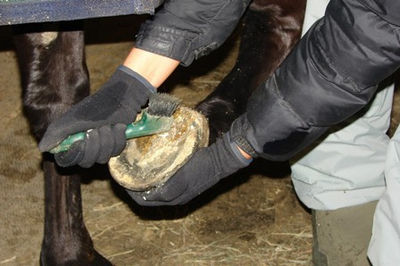Treating a seriously bleeding limb laceration will need your veterinarian’s care. But until the vet arrives, you may be able to do some triage.
First try to stop the bleeding by applying pressure to the wound. Use a towel or a pressure bandage – a good item to keep in your horse’s emergency kit.
Don’t panic if it appears that your horse is losing a lot of blood. An 1100 lb. horse has about 10 1/2 gallons (40 liters) of blood.
Look for lameness or gait abnormalities that may indicate internal bone or other structural damage.
When your vet arrives, s/he will check heart and respiration rates, color of mucous membranes to see if the horse is in shock. If vital signs are stable, the vet may administer a local anesthetic to the lacerated area to relieve some pain and be able to work on the wound.
The numbed area will then be cleaned with a sterile lubricant. The horse may require general anesthesia to further evaluate and treat the area. If the wound is very severe and/or surgery is required, the horse will have to be transported to the clinic.
Leg wounds, even those that appear minor, can involve inner structures which may become infected. For this reason, wounds should be checked by a vet as soon as possible. Your vet may advise an x-ray to make sure the internal parts of the leg are not damaged.
Your vet will prescribe medications for pain and inflammation and to prevent infection. Experts recommend stall rest.
When wounds are treated early, prognosis is good for recovery.



